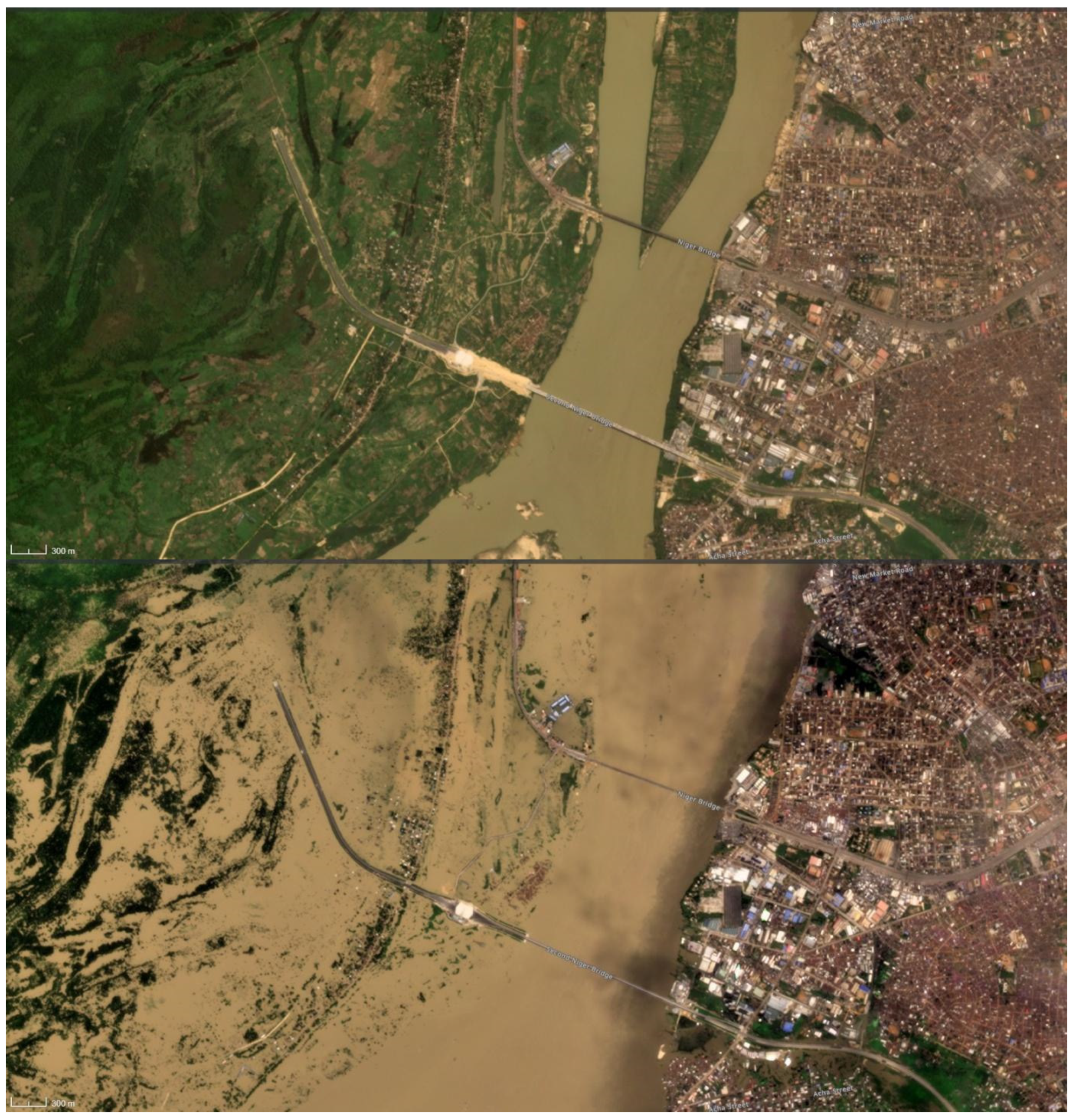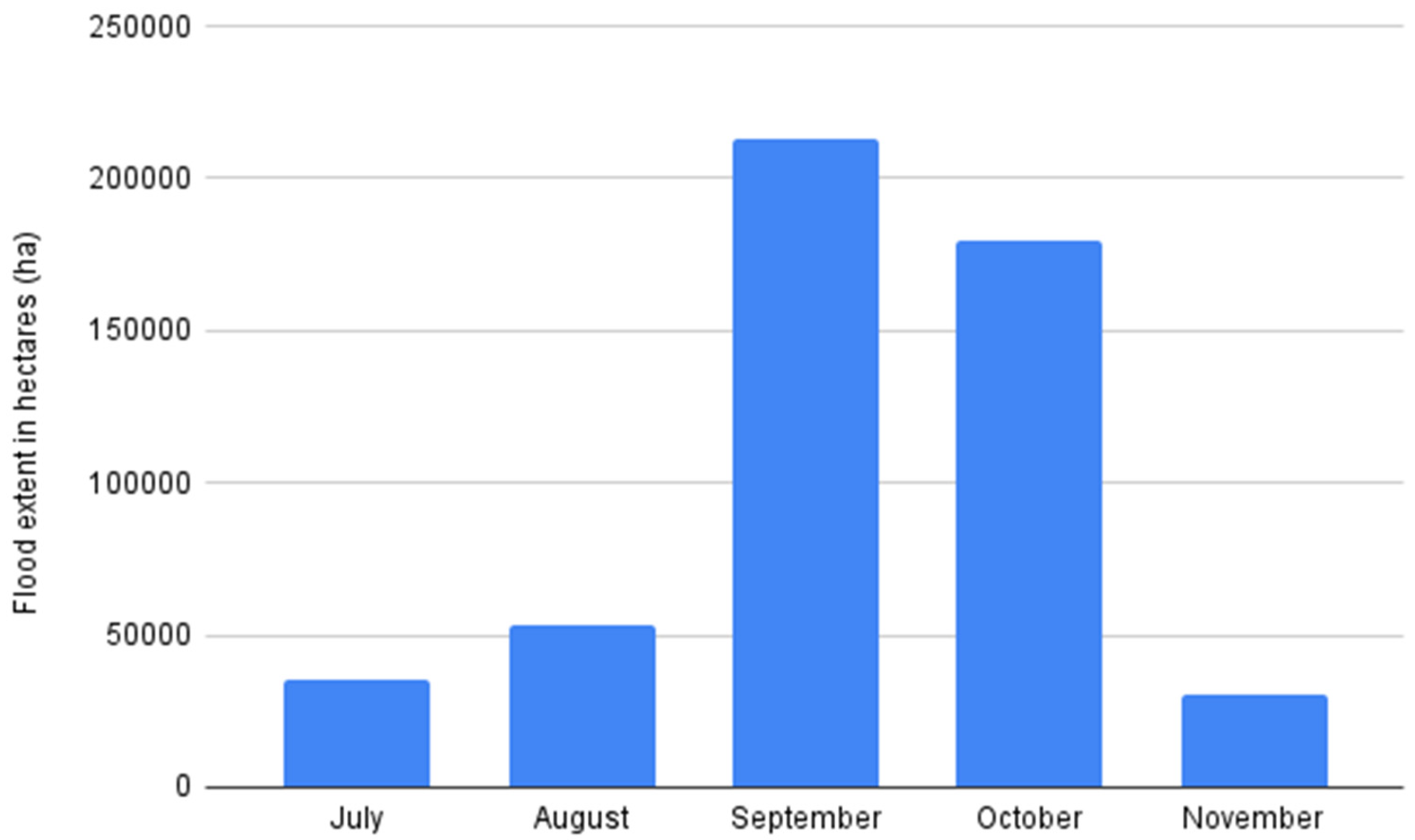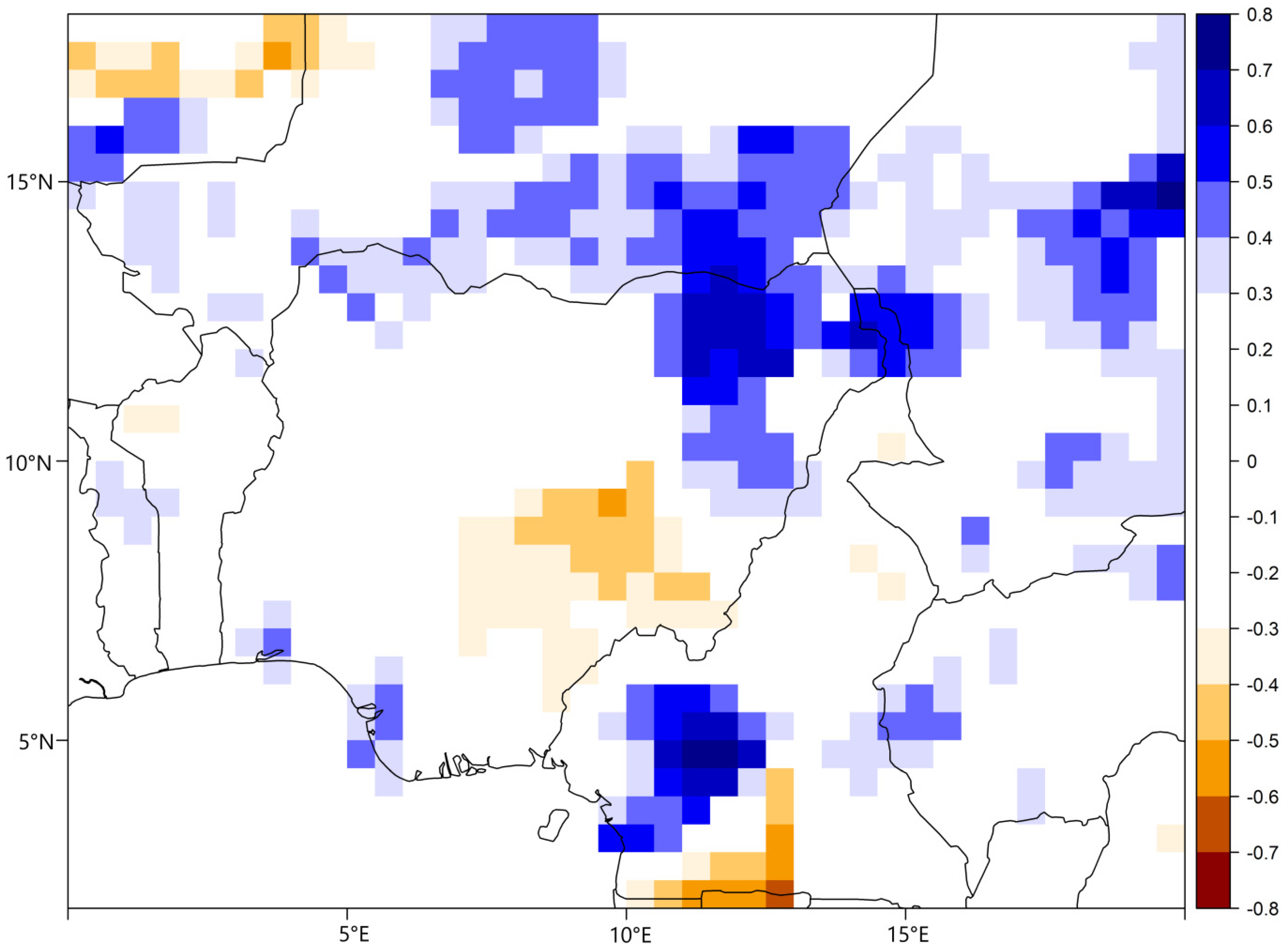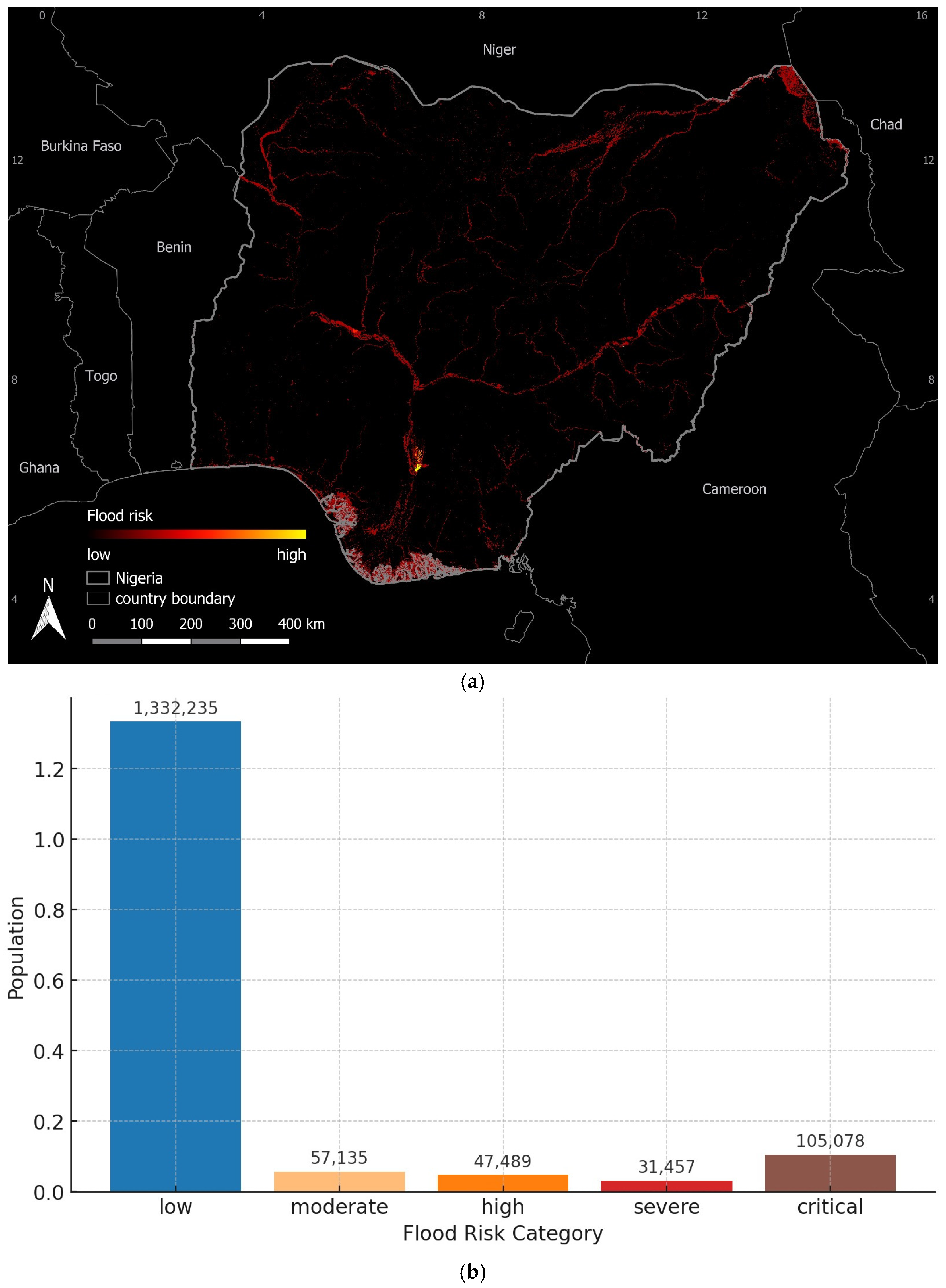Risk Assessment of the 2022 Nigerian Flood Event Using Remote Sensing Products and Climate Data
Abstract
1. Introduction
2. Materials and Methods
2.1. Study Area
2.2. Data
2.3. Flood Extent Mapping
2.4. Accuracy Assessment
2.5. Impact Assessment
2.6. Flood Risk Mapping
3. Results
4. Discussion
4.1. Proposed Early-Warning Systems for Nigeria: Lessons from Global Examples
4.2. Kenya’s Nzoia River Basin Flood Early-Warning System (Nzoia FldEWS)
4.3. Google’s AI-Powered Flood Forecasting Initiative
4.4. NASA’s Global Flood Monitoring System
4.5. Copernicus Global Flood Awareness System (GloFAS)
4.6. Application to Nigeria
5. Conclusions
- 1.
- The northern and middle-belt regions of Nigeria, including Yobe, Jigawa, Taraba, Bauchi, Sokoto, Niger, and Kogi, were the most impacted in terms of flood extent, with an estimate of over 32,000 ha of land inundated.
- 2.
- Regarding the number of people impacted, southern states, particularly Anambra, ranked highest, with more than 400,000 individuals affected. This high impact is attributed to elevated population density in flood-prone areas, exacerbating vulnerability to flood events.
- 3.
- Before the opening of the Lagdo Dam on 13 September 2022, northern and western parts of Nigeria experienced localized above-average rainfall, leading to soil saturation and flooding of approximately 50,000 ha of land. Following the dam’s opening, the flood extent increased by approximately 300%, reaching over 200,000 ha. However, due to the absence of hydrological modeling, our inference about the dam’s impact should be considered indicative rather than definitive.
- 4.
- Trends in heavy rainfall were positive in northern Nigeria and parts of Cameroon. The risk assessment of riverine flooding in Nigeria based on the 2022 conditions and pre-flood population data available as of the time of this study indicated that about 105,000 people were at critical risk, particularly in southern states such as Anambra. However, considering the dynamic nature of Nigeria’s population, using pre-flood datasets may slightly misrepresent the impact in highly dynamic areas.
Author Contributions
Funding
Data Availability Statement
Acknowledgments
Conflicts of Interest
References
- Rentschler, J.E.; Salahab, M. 1.47 billion people face flood risk worldwide: For over a third, it could be devastating. World Bank blogs, 12 November 2020. [Google Scholar]
- Nashwan, A.J.; Ahmed, S.H.; Shaikh, T.G.; Waseem, S. Impact of natural disasters on health disparities in low-to middle-income countries. Discov. Health Syst. 2023, 2, 23. [Google Scholar] [CrossRef]
- Salam, A.; Wireko, A.A.; Jiffry, R.; Ng, J.C.; Patel, H.; Zahid, M.J.; Mehta, A.; Huang, H.; Abdul-Rahman, T.; Isik, A. The impact of natural disasters on healthcare and surgical services in low-and middle-income countries. Ann. Med. Surg. 2023, 85, 3774–3777. [Google Scholar] [CrossRef] [PubMed]
- Lemos, M.C.; Agrawal, A.; Eakin, H.; Nelson, D.R.; Engle, N.L.; Johns, O. Building adaptive capacity to climate change in less developed countries. In Climate Science for Serving Society: Research, Modeling and Prediction Priorities; Springer: Dordrecht, The Netherlands, 2013; pp. 437–457. [Google Scholar]
- Brooks, N.; Adger, W.N.; Kelly, P.M. The determinants of vulnerability and adaptive capacity at the national level and the implications for adaptation. Glob. Environ. Change 2005, 15, 151–163. [Google Scholar] [CrossRef]
- Yang, L.; Scheffran, J.; Qin, H.; You, Q. Climate-related flood risks and urban responses in the Pearl River Delta, China. Reg. Environ. Change 2015, 15, 379–391. [Google Scholar] [CrossRef]
- Jiang, R.; Lu, H.; Yang, K.; Chen, D.; Zhou, J.; Yamazaki, D.; Pan, M.; Li, W.; Xu, N.; Yang, Y.; et al. Substantial increase in future fluvial flood risk projected in China’s major urban agglomerations. Commun. Earth Environ. 2023, 4, 389. [Google Scholar] [CrossRef]
- Lumbroso, D. Flood risk management in Africa. J. Flood Risk Manag. 2020, 13, e12612. [Google Scholar] [CrossRef]
- Salami, R.; Giggins, H.; von Meding, J. Vulnerability of human settlements to flood risk in the core area of Ibadan metropolis, Nigeria. Jàmbá J. Disaster Risk Stud. 2017, 9, 1–14. [Google Scholar] [CrossRef]
- Nigeria Flash Update (Flood), November 2022. Available online: https://www.unicef.org/documents/nigeria-flash-update-flood-november-2022 (accessed on 19 December 2022).
- 80% of Floods Caused by Rainfall NOT Lagdo Dam, Says Minister. TheCable. 20 October 2022. Available online: https://www.thecable.ng/80-of-floods-caused-by-rainfall-not-lagdo-dam-says-minister (accessed on 19 December 2022).
- Oyedepo, S.O. Energy and sustainable development in Nigeria: The way forward. Energy Sustain. Soc. 2012, 2, 1–17. [Google Scholar] [CrossRef]
- Olaniyan, E.; Adefisan, E.A.; Balogun, A.A.; Lawal, K.A. The influence of global climate drivers on monsoon onset variability in Nigeria using S2S models. Model. Earth Syst. Environ. 2019, 5, 1405–1428. [Google Scholar] [CrossRef]
- Nkeki, F.N.; Henah, P.J.; Ojeh, V.N. Geospatial techniques for the assessment and analysis of flood risk along the Niger-Benue Basin in Nigeria. J. Geogr. Inf. Syst. 2013, 5, 123–135. [Google Scholar] [CrossRef]
- AUdo, E.; Ojinnaka, O.C.; Baywood, C.N.; Gift, U.A. Flood hazard analysis and damage assessment of 2012 flood in Anambra State using GIS and remote sensing approach. Am. J. Geogr. Inf. Syst. 2015, 4, 38–51. [Google Scholar]
- Flooding: What you must know about Lagdo Dam. Punch Newspapers. 10 October 2022. Available online: https://punchng.com/flooding-what-you-must-know-about-lagdo-dam/ (accessed on 19 December 2022).
- Ibebuchi, C.C. Revisiting the 1992 severe drought episode in South Africa: The role of El Niño in the anomalies of atmospheric circulation types in Africa south of the equator. Theor. Appl. Climatol. 2021, 146, 723–740. [Google Scholar] [CrossRef]
- Mueller, W.A.; Roeckner, E. ENSO impact on midlatitude circulation patterns in future climate change projections. Geophys. Res. Lett. 2006, 33, L05711. [Google Scholar] [CrossRef]
- Shaker, A.; Yan, W.Y.; Wong, M.S.; El-Ashmawy, N.; Alhaddad, B.I. Flood hazard assessment using panchromatic satellite imagery. Int. Arch. Photogramm. Remote Sens. Spat. Inf. Sci.-ISPRS Arch. 2008, 37, 881–886. [Google Scholar]
- DeVries, B.; Huang, C.; Armston, J.; Huang, W.; Jones, J.W.; Lang, M.W. Rapid and robust monitoring of flood events using Sentinel-1 and Landsat data on the Google Earth Engine. Remote Sens. Environ. 2020, 240, 111664. [Google Scholar] [CrossRef]
- Pekel, J.-F.; Cottam, A.; Gorelick, N.; Belward, A.S. High-resolution mapping of global surface water and its long-term changes. Nature 2016, 540, 7633. [Google Scholar] [CrossRef]
- Farr, T.G.; Rosen, P.A.; Caro, E.; Crippen, R.; Duren, R.; Hensley, S.; Kobrick, M.; Paller, M.; Rodriguez, E.; Roth, L.; et al. The shuttle radar topography mission. Rev. Geophys. 2007, 45, RG2004. [Google Scholar] [CrossRef]
- Farr, T.G.; Kobrick, M. Shuttle Radar Topography Mission produces a wealth of data. Eos Trans. Am. Geophys. Union 2000, 81, 583–585. [Google Scholar] [CrossRef]
- Tatem, A.J. WorldPop, open data for spatial demography. Sci. Data 2017, 4, 170004. [Google Scholar] [CrossRef]
- Zanaga, D.; Van De Kerchove, R.; De Keersmaecker, W.; Souverijns, N.; Brockmann, C.; Quast, R.; Wevers, J.; Grosu, A.; Paccini, A.; Vergnaud, S.; et al. Zenodo—ESA WorldCover 10 m 2020 v100, Version v100; ESA: Paris, France, 2021. [Google Scholar]
- Funk, C.; Peterson, P.; Landsfeld, M.; Pedreros, D.; Verdin, J.; Shukla, S.; Husak, G.; Rowland, J.; Harrison, L.; Hoell, A.; et al. The climate hazards infrared precipitation with stations—A new environmental record for monitoring extremes. Sci. Data 2015, 2, 150066. [Google Scholar] [CrossRef]
- Hengl, T.; Mendes de Jesus, J.; Heuvelink, G.B.; Ruiperez Gonzalez, M.; Kilibarda, M.; Blagotić, A.; Wei, S.; Wright, M.N.; Geng, X.; Bauer-Marschallinger, B.; et al. SoilGrids250m: Global gridded soil information based on machine learning. PLoS ONE 2017, 12, e0169748. [Google Scholar] [CrossRef] [PubMed]
- Reichle, R.H.; De Lannoy, G.J.M.; Koster, R.D.; Crow, W.T.; Kimball, J.S.; Liu, Q. SMAP L4 Global 3-hourly 9 km EASE-Grid Surface and Root Zone Soil Moisture Geophysical Data, Version 4; NASA National Snow and Ice Data Center Distributed Active Archive Center: Boulder, CO, USA, 2018. [Google Scholar] [CrossRef]
- Franceschini, G.; Khan, A.; Moretti, L.; Nyabuti, K.; Asif, M.; Bezuidenhoudt, E.; Morteo, K. The Global Administrative Unit Layers (GAUL) 2024: Technical Guidelines; FAO: Rome, Italy, 2025. [Google Scholar] [CrossRef]
- Xie, P.; Chen, M.; Yang, S.; Yatagai, A.; Hayasaka, T.; Fukushima, Y.; Liu, C. A gauge-based analysis of daily precipitation over East Asia. J. Hydrometeorol. 2007, 8, 607–626. [Google Scholar] [CrossRef]
- Muñoz-Sabater, J.; Dutra, E.; Agustí-Panareda, A.; Albergel, C.; Arduini, G.; Balsamo, G.; Boussetta, S.; Choulga, M.; Harrigan, S.; Hersbach, H.; et al. ERA5-Land: A state-of-the-art global reanalysis dataset for land applications. Earth Syst. Sci. Data 2021, 13, 4349–4383. [Google Scholar] [CrossRef]
- Asokan, A.; Anitha, J. Guided filtering based real time flood area identification on bitemporal satellite images. In Proceedings of the 2021 Fourth International Conference on Electrical, Computer and Communication Technologies (ICECCT), Coimbatore, India, 15–17 September 2021; pp. 1–4. [Google Scholar]
- Priyatna, M.; Wijaya, S.K.; Khomarudin, M.R.; Yulianto, F.; Nugroho, G.; Afgatiani, P.M.; Rarasati, A.; Hussein, M.A. The use of multi-sensor satellite imagery to analyze flood events and land cover changes using change detection and machine learning techniques in the Barito watershed. J. Degrad. Min. Lands Manag. 2023, 10, 4073. [Google Scholar] [CrossRef]
- Tarhule, A. Damaging rainfall and flooding: The other Sahel hazards. Clim. Change 2005, 72, 355–377. [Google Scholar] [CrossRef]
- Biasutti, M. Rainfall trends in the African Sahel: Characteristics, processes, and causes. Wiley Interdiscip. Rev. Clim. Change 2019, 10, e591. [Google Scholar] [CrossRef]
- Taye, M.T.; Dyer, E. Hydrologic extremes in a changing climate: A review of extremes in East Africa. Curr. Clim. Change Rep. 2024, 10, 1–11. [Google Scholar] [CrossRef]
- Yabi, I.; Afouda, F. Extreme rainfall years in Benin (West Africa). Quat. Int. 2012, 262, 39–43. [Google Scholar] [CrossRef]
- Umar, N.; Gray, A. Flooding in Nigeria: A review of its occurrence and impacts and approaches to modelling flood data. Int. J. Environ. Stud. 2023, 80, 540–561. [Google Scholar] [CrossRef]
- Nouhou, Y.D.; Otache, M.Y.; Illiassou, S.A.; Okunola, O.H.; Okhimamhe, A.A.; Nguyen, T.T. Flood Risk Assessment and Zoning for Niamey and Lokoja Metropolises in Niger and Nigeria. Hydrology 2025, 12, 17. [Google Scholar] [CrossRef]
- Ibebuchi, C.C.; Abu, I.O. Rainfall variability patterns in Nigeria during the rainy season. Sci. Rep. 2023, 13, 7888. [Google Scholar] [CrossRef] [PubMed]
- Sanyal, J.; Lu, X.X. GIS-based flood hazard mapping at different administrative scales: A case study in Gangetic West Bengal, India. Singap. J. Trop. Geogr. 2006, 27, 207–220. [Google Scholar] [CrossRef]
- Islam, M.T.; Meng, Q. Spatial analysis of socio-economic and demographic factors influencing urban flood vulnerability. J. Urban Manag. 2024, 13, 437–455. [Google Scholar] [CrossRef]
- Stevens, A.J.; Clarke, D.; Nicholls, R.J.; Wadey, M.P. Estimating the long-term historic evolution of exposure to flooding of coastal populations. Nat. Hazards Earth Syst. Sci. 2015, 15, 1215–1229. [Google Scholar] [CrossRef]
- Tartiyus, E.H.; Dauda, T.M.; Peter, A. Impact of population growth on economic growth in Nigeria. IOSR J. Humanit. Soc. Sci. (IOSRJHSS) 2015, 20, 115–123. [Google Scholar]
- Oke, A.; Amarnath, G.; Okem, A.; Dembele, M. Strengthening Anticipatory Action Through Flood Forecasting and Early Warning Systems to Mitigate Flood Impacts in Nigeria (No. H052683); International Water Management Institute: Colombo, Sri Lanka, 2023. [Google Scholar]
- Kiptum, A.; Mwangi, E.; Otieno, G.; Njogu, A.; Kilavi, M.; Mwai, Z.; MacLeod, D.; Neal, J.; Hawker, L.; O’Shea, T.; et al. Advancing operational flood forecasting, early warning and risk management with new emerging science: Gaps, opportunities and barriers in Kenya. J. Flood Risk Manag. 2025, 18, e12884. [Google Scholar] [CrossRef]
- Nearing, G.; Cohen, D.; Dube, V.; Gauch, M.; Gilon, O.; Harrigan, S.; Hassidim, A.; Klotz, D.; Kratzert, F.; Metzger, A.; et al. Global prediction of extreme floods in ungauged watersheds. Nature 2024, 627, 559–563. [Google Scholar] [CrossRef]
- Matias, Y. Available online: https://blog.google/technology/ai/google-ai-global-flood-forecasting/ (accessed on 14 January 2025).
- NASA Applied Sciences. 2024; Floods. Available online: https://appliedsciences.nasa.gov/what-we-do/disasters/floods (accessed on 14 January 2025).
- Global Flood Awareness System (GloFAS). Copernicus Emergency Management Service. 2025. Available online: https://global-flood.emergency.copernicus.eu/technical-information/products/ (accessed on 14 January 2025).
- Ibebuchi, C.; Abu, I.-O.; Zenodo. NaijaFloodWatch. 2025. Available online: https://naijafloodwatch.streamlit.app/ (accessed on 2 May 2025).
- Python Software Foundation. Python; Version 3.9; 2020; Available online: https://www.python.org (accessed on 14 January 2025).












| Dataset | Resolution | Purpose |
|---|---|---|
| Sentinel-1 Ground Range Detected (GRD) [20] | 10 m | Detection and calculation of flood extent, capturing rainfall and Lagdo Dam-driven flooding |
| Joint Research Centre (JRC) Global Surface Water Mapping Layers [21] | 30 m | Masking permanent water bodies to focus on temporary flooding |
| Shuttle Radar Topography Mission (SRTM) [22,23] | 30 m | Elevation and slope derivation for identifying low-lying flood-prone areas |
| WorldPop Global Project for 2020 global population data [24] | 100 m | Population exposure assessment to identify human presence in flood zones |
| European Space Agency (ESA) WorldCover for 2021 [25] | 10 m | Land cover classification for vulnerability assessment (e.g., croplands, settlements) |
| Climate Hazards Group InfraRed Precipitation with Station Data (CHIRPS) [26] | 5566 m (0.05°) | Rainfall aggregation to quantify precipitation driving 2022-like floods |
| SoilGrids [27] | 250 m | Clay content analysis to assess soil water retention capacity |
| National Aeronautics and Space Administration (NASA) Soil Moisture Active Passive (SMAP) Level 4 [28] | 9000 m | Soil moisture estimation to capture saturation levels during flood season |
| Food and Agriculture Organization (FAO) Global Administrative Unit Layers (GAUL) [29] | Vector (country-level) | Defining Nigeria’s boundaries for analysis scope |
Disclaimer/Publisher’s Note: The statements, opinions and data contained in all publications are solely those of the individual author(s) and contributor(s) and not of MDPI and/or the editor(s). MDPI and/or the editor(s) disclaim responsibility for any injury to people or property resulting from any ideas, methods, instructions or products referred to in the content. |
© 2025 by the authors. Licensee MDPI, Basel, Switzerland. This article is an open access article distributed under the terms and conditions of the Creative Commons Attribution (CC BY) license (https://creativecommons.org/licenses/by/4.0/).
Share and Cite
Abu, I.-O.; Ibebuchi, C.C. Risk Assessment of the 2022 Nigerian Flood Event Using Remote Sensing Products and Climate Data. Remote Sens. 2025, 17, 1814. https://doi.org/10.3390/rs17111814
Abu I-O, Ibebuchi CC. Risk Assessment of the 2022 Nigerian Flood Event Using Remote Sensing Products and Climate Data. Remote Sensing. 2025; 17(11):1814. https://doi.org/10.3390/rs17111814
Chicago/Turabian StyleAbu, Itohan-Osa, and Chibuike Chiedozie Ibebuchi. 2025. "Risk Assessment of the 2022 Nigerian Flood Event Using Remote Sensing Products and Climate Data" Remote Sensing 17, no. 11: 1814. https://doi.org/10.3390/rs17111814
APA StyleAbu, I.-O., & Ibebuchi, C. C. (2025). Risk Assessment of the 2022 Nigerian Flood Event Using Remote Sensing Products and Climate Data. Remote Sensing, 17(11), 1814. https://doi.org/10.3390/rs17111814









